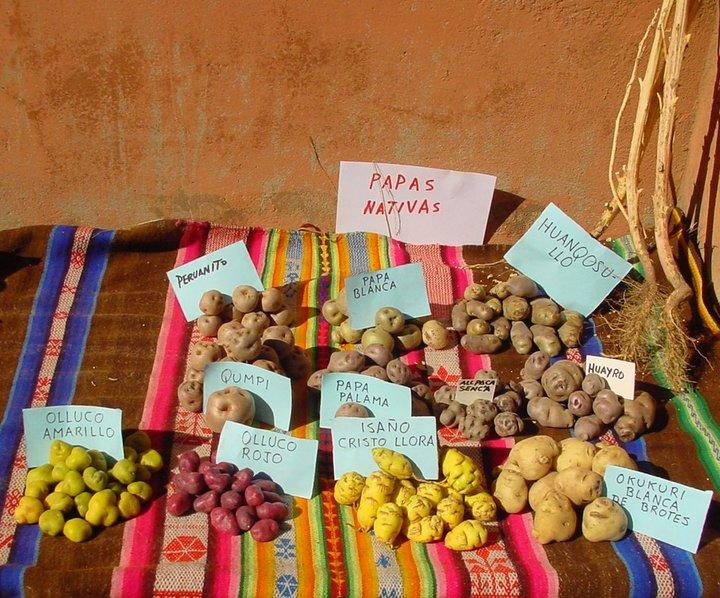How is agrobiodiversity faring in Peru?

Did you know that Peru is one of the main centres of crop diversity in the world? A recent study conducted by Bioversity International sets the stage for further actions to protect, conserve and boost agrobiodiversity use in the country to nourish people and sustain the planet.
With 184 native domesticated plant species and hundreds of varieties, Peru is one of the richest centres of crop diversity and domestication in the world. The Andean region of Peru alone hosts over 3,000 varieties of potatoes.
The value of this diversity goes well beyond Peruvian borders. Agricultural biodiversity is one of the key ingredients to build sustainable food systems. Not only does it contribute to nutrition security through diet diversity, but it also helps manage production risks and provides future food growing options for us all.
But how much agrobiodiversity does Peru host? How can we better take advantage of this richness to build sustainable food systems? Bioversity International and partners have worked together to answer these questions, through the Agrobiodiversity Index. Initial results from the study were presented during a webinar held on 17 October in Peru, attended by over fifty stakeholders from the public, private sector and academia.

To manage agrobiodiversity, we need to measure it
“This innovative tool responds to the need for a standardized way to measure agrobiodiversity. It will help governments, development partners, investors and companies to evaluate risks and seize opportunities in food and agriculture,” explained Roseline Remans, one of the principal investigators behind the Agrobiodiversity Index, during the webinar.
The Index helps understand how agrobiodiversity contributes to healthy diets, sustainable production and genetic resource conservation. The tool is essential to capture the status of agricultural biodiversity in a country – that is the current state of diversity of crops, livestock and pollinators at different levels (varietal, species, farm, landscape and ecosystem) – as well as commitments and actions to use it, protect it, conserve it and boost it.
“To measure the status of agrobiodiversity, we look at globally available data from different sources, including databases from the Food and Agriculture Organization of the UN and the Global Biodiversity Information Facility”, said Remans. “For commitments, we review national policies and guidelines that impact agrobiodiversity, such as national Agricultural and Biodiversity Strategic Plans. And for actions, we look at progress on implementing practices that support agrobiodiversity, based on FAO guidelines, such as percentage of land under agroforestry or in mixed crop–livestock systems,” she continued.
What does the Index tell us about agrobiodiversity in Peru?
When it comes to the Status “the Index shows high levels of agrobiodiversity in Peru, particularly in food supply and genetic resource conservation,” said Sarah Jones, co-principal investigator of the Index. Some Commitments and Actions are in place in Peru, both in the public and private sector sphere, to use and conserve agrobiodiversity. The Ministry of Agriculture for example supports smallholder farmers through the recognition of agrobiodiversity zones, and the creation of the National Centre for Genetic Resources of Agrobiodiversity.
The private sector can also play a part. Agricultural biodiversity not only helps companies to respond to consumer’s interest in new flavours and nutritious foods, but it is also a strategy to manage operational risks that could make value chains more resilient, for example to price fluctuations and disease outbreaks that affect specific crops or varieties.

Pollinators matter
Food production systems rich in agrobiodiversity can also enhance the provision of ecosystem services. In agriculture, these vital services include pollination. Pollinators such as birds, butterflies and bees, play a crucial role in the production of most fruits and vegetables, contributing to healthy diets and nutrition.
"Different types of pollinators can have complementary functions. This complementarity contributes to a balanced ecosystem that favours agricultural production,” explained Costanza Geppert, a member of the research team.
The Index was used to understand the effects of different land uses (pasture, cultivation, etc.) on pollinator diversity in a 15,000 ha reserve located in the Andes established to conserve the region’s potato biodiversity. The Index shows that more intense land management within the Potato Park has a negative impact on pollinator diversity posing a risk to pollinator-dependent crops.
Seizing opportunities to nourish people and sustain the planet
The Index shows that Peru is well positioned to take advantage of its agrobiodiversity richness to build a sustainable food system. “Peru is doing well in terms of genetic resource management for future use options. Commitments and Actions can be further strengthened to ensure the existing agrobiodiversity is protected and better utilized to build more sustainable food systems,” highlighted Sarah Jones.
This can be done by increasing awareness of the importance of agricultural biodiversity for healthy diets and sustainable production.“Agrobiodiversity is with no doubt one of the strengths of our country. Protecting and boosting its use means helping farmers and producers, who are the custodian of this global treasure,” highlighted a representative from a Peruvian corporate. “The Index is a very important tool because it gathers information on biodiversity across the world, including in Peru. This is crucial for successful decision-making, not only for the Government but also for corporates. If we don’t have information, it is much more difficult to make the right investments or take the right action to build sustainable, profitable and resilient food systems,” he continued.
_____________________
This work is supported by the Italian Agency for Development Cooperation, the European Commission and CGIAR Trust Fund Donors, and contributes to the CGIAR Research Program on Agriculture for Nutrition and Health (A4NH).
